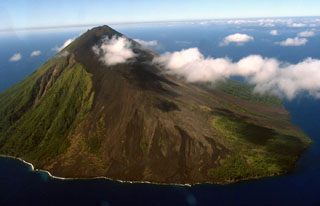Report on Lopevi (Vanuatu) — May 2015
Bulletin of the Global Volcanism Network, vol. 40, no. 5 (May 2015)
Managing Editor: Edward Venzke.
Research and preparation by Paul Berger.
Lopevi (Vanuatu) Increased volcanic unrest in December 2014
Please cite this report as:
Global Volcanism Program, 2015. Report on Lopevi (Vanuatu) (Venzke, E., ed.). Bulletin of the Global Volcanism Network, 40:5. Smithsonian Institution. https://doi.org/10.5479/si.GVP.BGVN201505-257050
Lopevi
Vanuatu
16.507°S, 168.346°E; summit elev. 1413 m
All times are local (unless otherwise noted)
Following the eruptive activity in April-May 2007, Lopevi remained quiet through May 2015 except for the sighting of a gray plume on 24 February 2008 (BGVN 34:08) and an increase in volcanic activity in December 2014. No thermal anomalies, based on MODIS satellites data, have bene observed since the 2007 eruption.
On 15 December 2014, the Vanuatu Geohazards Observatory (VGO) reported that, based on observations and analyses in early December, volcanic activity had increased dramatically over a short time period. No additional details about the type of activity were available. The Alert Level was raised to 1 (on a scale of 0-4), and access to the island was prohibited.
Geological Summary. The small 7-km-wide conical island of Lopevi, known locally as Vanei Vollohulu, is one of Vanuatu's most active volcanoes. A small summit crater containing a cinder cone is breached to the NW and tops an older cone that is rimmed by the remnant of a larger crater. The basaltic-to-andesitic volcano has been active during historical time at both summit and flank vents, primarily along a NW-SE-trending fissure that cuts across the island, producing moderate explosive eruptions and lava flows that reached the coast. Historical eruptions at the 1413-m-high volcano date back to the mid-19th century. The island was evacuated following major eruptions in 1939 and 1960. The latter eruption, from a NW-flank fissure vent, produced a pyroclastic flow that swept to the sea and a lava flow that formed a new peninsula on the western coast.
Information Contacts: Vanuatu Geohazards Observatory (URL: http://www.vmgd.gov.vu/vmgd/); Hawai'i Institute of Geophysics and Planetology (HIGP) Thermal Alerts System, School of Ocean and Earth Science and Technology (SOEST), Univ. of Hawai'i, 2525 Correa Road, Honolulu, HI 96822, USA (URL: http://modis.higp.hawaii.edu/).

